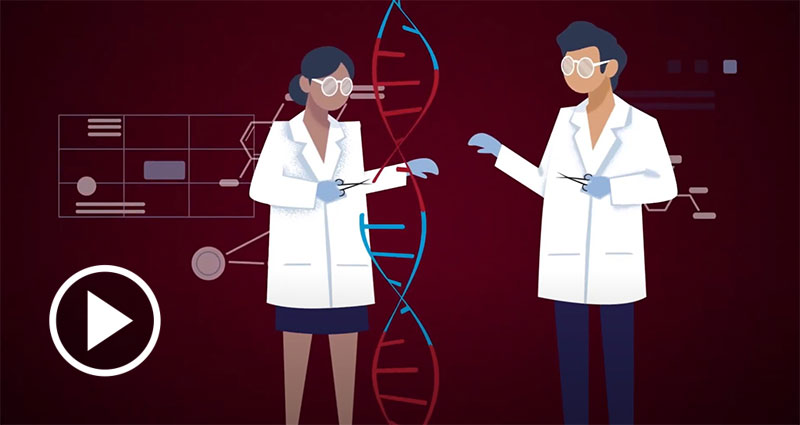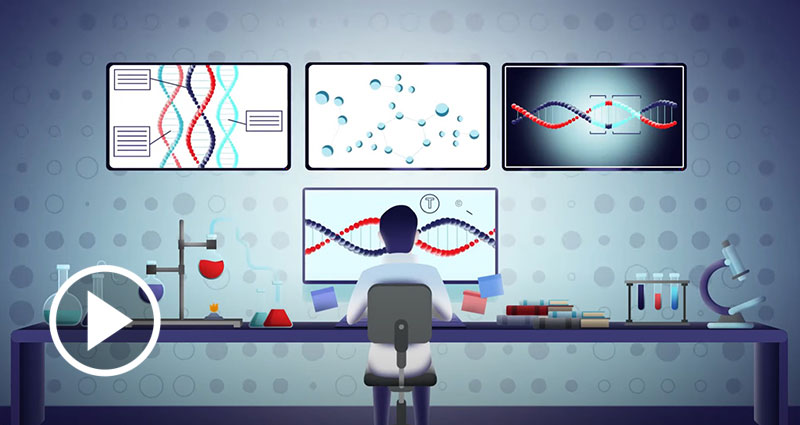A comprehensive guide to CRISPR gene editing
CRISPR gene editing has emerged as one of humanity’s most powerful technologies in the pursuit of a greater understanding of human health and disease. Less expensive and relatively easy to design, the next generation of CRISPR tools is now allowing researchers to target almost any gene for modification in a highly specific and reliable way.
In this interactive guide, we outline a variety of resources that will provide all you need to know in order to overcome existing hurdles and design successful CRISPR gene editing experiments. Explore expert interviews, free downloads, webinars, videos and more.
A brief history of CRISPR
Watch the video series below, narrated by Yasmin Dickinson from University of Oxford, to explore the history of CRISPR and gene editing, from its ground-breaking discovery to the revolutionary contributions of various scientists.
Insights from the gene editing experts
“The ability to edit multiple gene targets simultaneously is becoming increasingly achievable at scale”
Dr. Panos Zalmas, Head of the Open Targets Validation Lab based at the Wellcome Sanger Institute, shares how he is working to improve the rate of target adoption into drug discovery pipelines across therapy areas such as oncology, neurodegeneration, and immunology and inflammation. Here, Zalmas explains the importance of gene editing in his target validation workflows and highlights how CRISPR technologies in particular are key to the success of drug discovery.
“Every patient should be able to have a personalized and precision medicine program”
Dr. Sergio Casas-Tintó, head of the Drosophila Models of Human Disease Unit at the Institute for Rare Diseases Research (IIER) of ISCIII (Instituto de Salud Carlos III), and his team work to develop disease models to validate genetic determinants of rare diseases. Find out how advances in gene editing technology have allowed his team to more accurately model these candidate genetic variants and discover Dr. Casas-Tintó’s hopes for the future of the field.
“Advances in genome editing provide a path to do this engineering in a cleaner way”
Dr. Krishanu Saha, associate professor of biomedical engineering at the University of Wisconsin-Madison, and his team use a nascent CRISPR-Cas9 gene editing method to generate CAR T-cells for the treatment of solid tumors. Discover how this approach can circumvent the challenges of conventional viral-based methods and explore the potential of CRISPR for improving CAR T-cell efficacy.
“CRISPR is a more versatile and easier-to-design approach”
Dr. Yu Holly Chen, Assistant Professor at the University of Alabama, and Dr. Rinki Ratnapriya, Assistant Professor at the Baylor College of Medicine, are combining their respective expertise in developing in vivo models for retinal diseases to uncover the mechanisms by which non-coding variants regulate the expression of genes known to play a role in age-related macular degeneration (AMD). Read on to see how they are employing sequencing-based genome-wide methods in this work.
Hear about the latest CRISPR innovations in these on-demand webinars
The revolution of CRISPR genome editing: An expert panel discussion
During this discussion, hear from a panel of key industry leaders on how they are leveraging CRISPR gene editing technology to advance their research, the potential CRISPR holds for future research applications, and so much more.
Advancing CRISPR gene editing applications: The webinar series
In this three-part webinar series, learn about CRISPR best practices, overcoming limitations, and how the use of gene editing technology is enabling a variety of advanced applications such as cancer immunotherapy and species de-extinction. Register below for free access. Meet our webinar speakers below!
CRISPR gene editing of human primary NK and T cells for cancer immunotherapy

Meisam Naeimi Kararoudi
Director of CRISPR/Gene Editing Core, Ohio State University
Key considerations in genome editing
In this comprehensive eBook, explore an innovative suite of CRISPR-based editing tools designed to support both basic and applied research applications. Find out how these tools can be used to improve fidelity and efficiency along every stage of a gene editing workflow – from guide RNA (gRNA) design to cell transfection and characterization of successful edits.
Download your free copy for guidance on how to:
- Design your genome editing experiments with ease
- Achieve high editing efficiency
- Leverage CRISPR for target identification
- Seamlessly transition from bench to clinic
Cas9 proteins vs plasmids
CRISPR-Cas9 systems provide a platform for direct and high-efficiency modification of genomic DNA. However, the delivery of Cas9 and synthesis of guide RNA (gRNA) remain limiting factors in the gene editing workflow. Cas9 proteins are gaining popularity due to their promising predictability, efficiency, and robustness in delivery and editing, along with overall ease of use and time savings.
This infographic outlines the key benefits of using Cas9 proteins in your gene editing experiments, including the reduction of experimental time by up to 50%.
For more insight into the use of CRISPR-Cas9 systems, download the two additional infographics below.
Discover CRISPR-Cas9 best practises and troubleshooting advice to help optimize your gene editing workflows
Download infographic>>
Further explore the potential of CRIPSR-Cas9 in driving cell engineering for more specific cell-based therapies
Download infographic>>
Your trusted gene editing partner - Thermo Fisher Scientific
Thermo Fisher Scientific has developed a suite of comprehensive solutions, optimized protocols, and trusted support to meet your needs at every step in the gene editing workflow.
Design your CRISPR gene editing experiments in as little as five minutes
Explore the key considerations for designing a successful and precise CRISPR gene editing experiment and see how the Invitrogen™ TrueDesign™ Genome Editor software and associated tools can help support every step in your gene editing workflow.
Looking to overcome challenges in your gene editing workflow?
Dr. Jason Potter, Director of Cell Biology R&D at Thermo Fisher Scientific, speaks to SelectScience® about advances in gene editing, the barriers that exist for developers, and how Thermo Fisher Scientific can support your workflow.

From gRNA design and cell transfection reagents through genetic analysis and phenotype analysis solutions, discover a complete set of tools from Thermo Fisher Scientific comprising optimized, validated systems that have been designed to work together to facilitate genome editing projects.
Featured products
Invitrogen™ TrueDesign™ Genome Editor
A free online tool that enables researchers to easily design, select, and order reagents
Invitrogen™ TrueGuide™ Synthetic Guide RNAs
Ready-to-transfect CRISPR sgRNAs for specific and high-efficiency knockout of target genes
Invitrogen™ TrueTag™ Donor DNA Kits
Easily create transfection-ready donor DNA for gene tagging
Invitrogen™ TrueCut™ Cas9 Protein v2
Next-generation wild-type Cas9 protein designed to deliver maximum efficiency
Invitrogen™ TrueCut™ HiFi Cas9 Protein
Cas9 variant engineered to offer improved specificity and high efficiency
Gibco™ CTS™ TrueCut™ Cas9 Protein
GMP-manufactured Cas9 protein designed for use in clinical research









